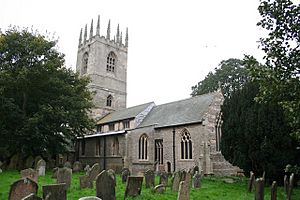St Peter and St Paul's Church, Sturton-le-Steeple facts for kids
Quick facts for kids St Peter and St Paul’s Church, Sturton-le-Steeple |
|
|---|---|

St Peter and St Paul’s Church, Sturton-le-Steeple
|
|
| 53°20′42.9″N 0°49′9.58″W / 53.345250°N 0.8193278°W | |
| Location | Sturton le Steeple |
| Country | England |
| Denomination | Church of England |
| History | |
| Dedication | St Peter and St Paul |
| Architecture | |
| Heritage designation | Grade II* listed |
| Specifications | |
| Bells | 6 (Cast Iron Frame) |
| Administration | |
| Parish | Sturton le Steeple |
| Deanery | Bassetlaw and Bawtry |
| Archdeaconry | Newark |
| Diocese | Southwell and Nottingham |
| Province | York |
St Peter and St Paul's Church is an old church in Sturton le Steeple, a village in Nottinghamshire, England. It is a Grade II* listed building, which means it's a very important historical place. The church belongs to the Church of England. It is currently part of a group of churches called the Clays Group.
A Look Back in Time
This church has been around for a very long time! It was first built in the 12th century, which is over 800 years ago. Sadly, in 1901, the church was damaged by a fire. But don't worry, it was quickly rebuilt by an architect named Charles Hodgson Fowler and opened again in 1902.
A very important person named John Robinson was born in Sturton-le-Steeple in 1576. He was known as the "Pilgrim Pastor." He helped lead a group of people called the Pilgrims who sailed to America to start new lives.
The Church Bells
Inside the church tower, there are six bells. They are held in a special cast iron frame that was designed to hold eight bells. Most of these bells were made in 1825 by a bell maker named Thomas II Mears. The smallest bell, called the treble, was made much later in 1991 by John Taylor & Co. The largest bell, called the tenor, weighs about 10 hundredweight (which is about 500 kilograms!). The treble bell weighs about 5 hundredweight (about 250 kilograms).
Important Monuments
Inside the church, you can find special monuments. These are like memorials to important people from the past. There are monuments for Lady Oliva de Montbegon, who passed away in 1236, and Dame Frances Earle, who passed away in 1687.
You can also see a marble slab that marks the grave of Francis Thornhagh. He was a commander for the Parliament during a war in England. He was killed in a battle called the Battle of Preston in 1648.

